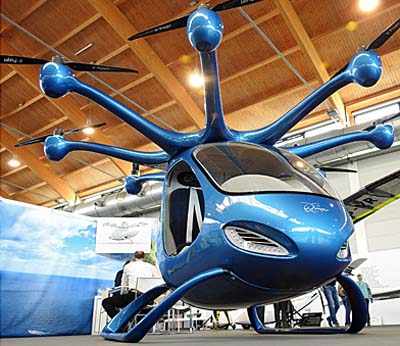 UPDATE (5/28/18): Since this article was published, we’ve added our video interview from Aero 2018.
UPDATE (5/28/18): Since this article was published, we’ve added our video interview from Aero 2018.
For your holiday reading about flying machines, I want to veer off into the weeds for one article. Don’t worry; lots more conventional reporting will follow.
After the Uber Elevate conference, mainstream media was all over eVTOLs like bees on flowers in spring. Breathless stories abound regarding how we will soon all take autonomously-flown taxis around our big cities, saving time and restoring the planet’s environmental health. Yeah, maybe… we’ll see about all that.
Imagine this…
What if you had guests over for the holiday and one arrives in the bright blue machine pictured nearby. Would you go look at it? More importantly, what if the owner said, “Let’s go for a short flight; you can see your home and neighborhood from above and it will only take a few minutes.”
Indeed, what if he threw you the keys and said, “You can go by yourself if you like.”
“But I don’t know how to fly a helicopter,” you plead, knowing the machine in your driveway is not a helicopter.
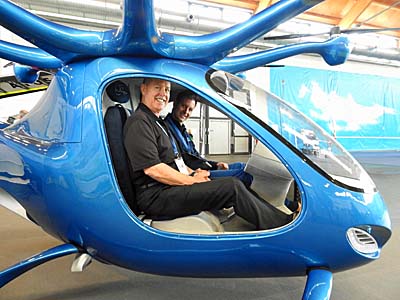 “Oh, don’t worry,” your friend replies. “Just move the joystick as you’d expect. If anything goes wrong, just hit the big red button and it will safely return you to precisely where you took off.”
“Oh, don’t worry,” your friend replies. “Just move the joystick as you’d expect. If anything goes wrong, just hit the big red button and it will safely return you to precisely where you took off.”
“But what about the batteries …what I run low on juice?”
“Ah, don’t sweat that either. The machine knows and it will land you safely before you run out of power.”
Would you, the expert fixed wing pilot, take the offer? Would someone else who always wanted to fly, but who was put off by the challenges of learning to fly conventional aircraft, want to take the offer?
Dare to Whisper?
A French company called Electric Aircraft Concept is developing Whisper, an 8-motor, 8-rotor, 2-seater. I examined and sat in the electric rotorcraft displayed at Aero Friedrichshafen 2018. Not autonomous, this one is clearly made to be flown, as you might correctly infer from its joystick.
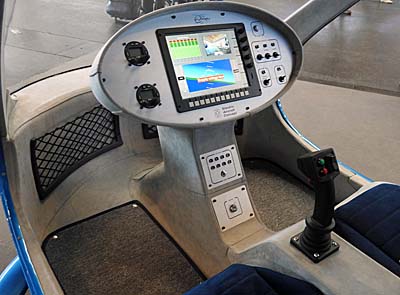
Current flight time is up to thirty minutes, they said, but representatives — like pretty much everybody else in the electric airplane development game — expect battery life to be increased with future technology.
An emergency parachute is part of the concept, however, it will also be possible to land in the case of a single rotor failure. It’s actually quite believable that with eight motors/rotors, the loss of one could be fairly easily remedied with the others. It’s just software …although that unveils the vulnerability in the near-future forecasts by some media.
Ready “Soon?”
Others are skeptical over positive development in battery technology. Does an alternative exist?
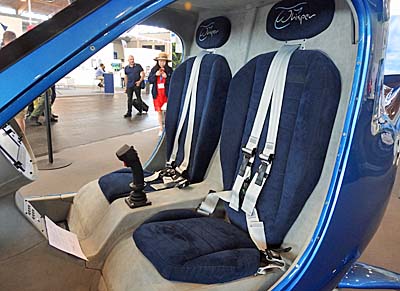
Developer Miles Garnett, President & CEO of Gestalt Aeronauticals, said the answer is fuel cells using hydrogen as the fuel. Indeed, this is the most plentiful stuff in the universe and it’s been working fine to power the Sun for the last few billion years. The trouble is storing the hydrogen. You can use tanks with gas or liquified hydrogen but both present huge challenges.
Miles and others refer to hydrogen storage using incombustible polymer. “Incombustible” sounds good, better than those persistent reports of eVehicles catching fire …perhaps not often but with real problems when a fire does start.
Instead of tanks with liquid or gas, Miles and others talk about hydrogen stored “in materials,” that is by binding the hydrogen to a solid. The science on this appears well developed.
Miles makes his point about the advisability of fuel cell engines employing hydrogen in a material form. It potentially offers far longer flight endurance in flight and won’t catch fire the same way densely-packed lithium batteries can, he wrote. Multiple sources reference the bursting-into-flames problem but perhaps chief among them in regards to battery-electric aircraft is FAA, which appears to have significant fear of lithium batteries on board aircraft.
Are Miles and his hydrogen fuel cell developers the only ones singing the praises of this technology? Nope.
He reported that Mazda will release their RX9 in 2019. This updated model produces 400 horsepower using a rotary engine that he said “has solved all the problems of the previous models.” But here’s the kicker. The new rotary engine can work with either gasoline or hydrogen. Adapting their technology should allow for a VTOL personal plane.
Future of Flight?
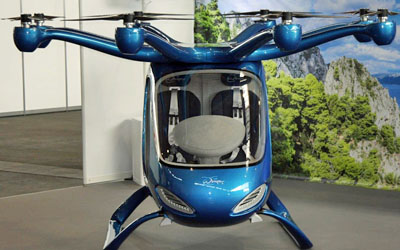
I admit I am slowly being swayed from my love of conventional winged aircraft that I know so well to something with spinney or flippy propulsion. Oh, I don’t see anything to replace the efficiency of fixed wings, for example, in the case of a gliding/soaring aircraft (think: sailplane or hang glider) but for many kinds of powered aircraft …well, the times, they may be a-changing.
I’ll try not to overdo this reporting and for the next decade or so, developments will keep octocopters and such in the aerial lab, so to say. Meanwhile, the great news is that we have an embarrassment of riches with many choices of ultralights, light kit aircraft, and Light-Sport Aircraft. I hope you can enjoy one on this holiday!
And now… here is our video interview:


I would like to suggest extending the tail. This will help counter crosswinds but, perhaps more importantly, will add to the visual appeal and engender a feeling of safety (polliwogs/tadpoles are inherently ‘cute’).
Buses in Mexico City run on hydrogen.I believe it is infused into gell-making escape of the hydrogen slow if the tank is damaged. Love to have more specs though. Max lift of each rotor? Etc.
Why is there no mention of flight times and load capacity?
Hi Don: Flight time was quoted at 30 minutes. No information was provided about loading; honestly, it’s probably premature.
The “high octane” humming bird can fly about 20 min. without eating. It has very little glide capabilities. It was designed for one main purpose – which we are grateful for. I am still trying to figure out the purpose for a VTOL. It seems like the goal now is just to get in the air. The bird makes more sense because it can eat while flying. Everything keeps coming back to the need for a charging system. That is why we developed a 96 Hp charger that uses a 24 pound engine to maintain flight.
“just to get in the air” works for a lot of flyers